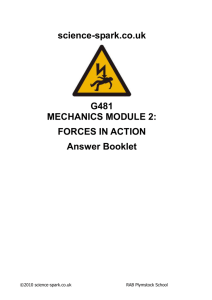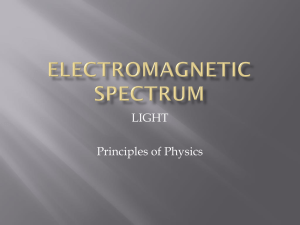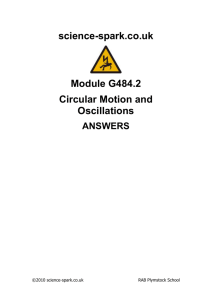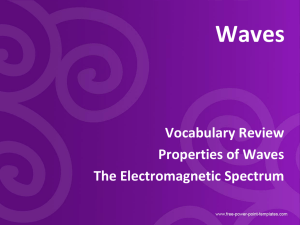Physics Waves Answer Booklet: Electrons, Photons, EM Spectrum
advertisement
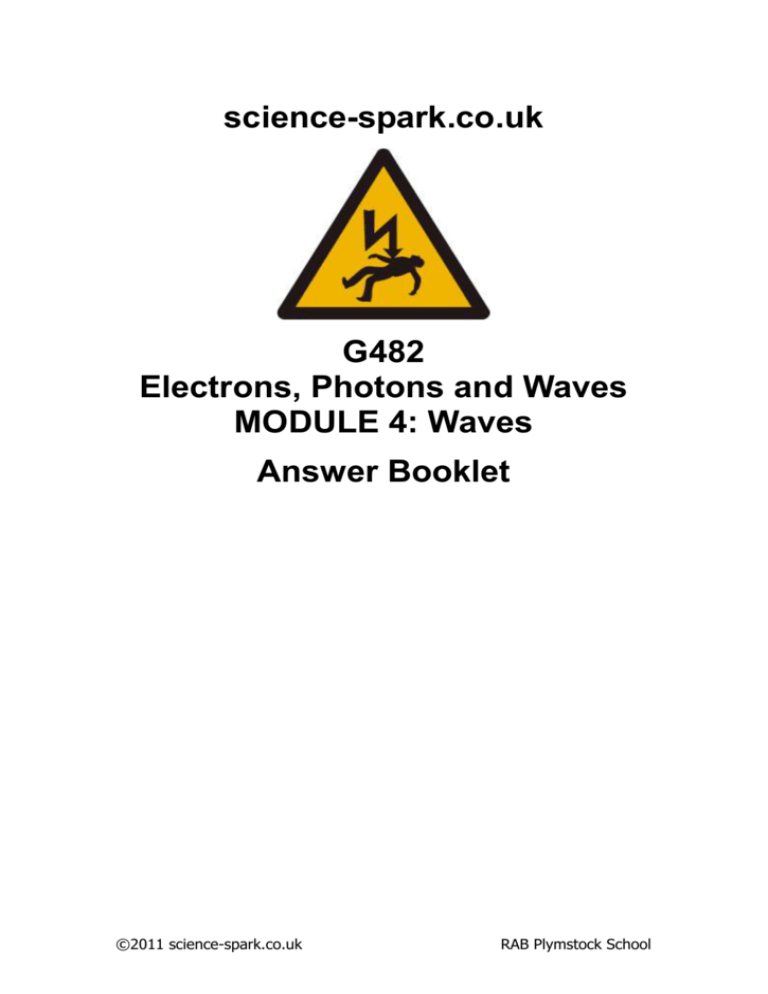
science-spark.co.uk G482 Electrons, Photons and Waves MODULE 4: Waves Answer Booklet ©2011 science-spark.co.uk RAB Plymstock School Lesson 21 – The wave equation 1 (a) Define the following terms associated with waves. (i) frequency f .................the number of waves per second........................................................... ...................................................................................................................................[1] (ii) wavelength λ .................the distance between two similar consecutive points on a wave train...... ...................................................................................................................................[1] (b) Use the definitions in (a) to deduce an equation for the speed v of a wave in terms of λ and f. f=1/T follows that T = 1/f λ=distance speed = distance/time speed = λ/(1/f) speed = f λ [3] (i) The speed of sound in air is about 340 m s–1 while light travels at a speed of 3.0 × 108 m s–1. Calculate the time interval between seeing a flash of lightning, 1.0 km away, and hearing the sound of thunder caused by the lightning. Speed=dist/time Time=dist/speed Time to take light: t=1000/(3.0 × 108) =3.33x10-6 Time to take sound: t=1000/(340) =2.94 Difference = 2.94-3.33x10-6 (c) time interval = .............2.94.......................................... s [3] (ii) Describe how observers may estimate their distance away from the point of a flash of lightning. ............counting the seconds from seeing the flash to hearing the thunder. Every three seconds = 1000km....................................................................................... ....................................................................................................................................... ...................................................................................................................................[1] (d) State two differences, other than their speeds, between sound and light waves. ..................sound is longitudinal and needs particles to travel............................... ....................................................................................................................................... ...................................................................................................................................[2] [Total: 11] Turn over for question 2 ©2011 science-spark.co.uk RAB Plymstock School 2 Label both of the diagrams appropriately with the key words below. You can use some of the keywords on both diagrams. You will gain one mark for each correct use of the word (maximum of once per diagram) Longitudinal Wavelength compression rarefaction Wavelength Amplitude crest Total [9] Transverse trough ©2011 science-spark.co.uk RAB Plymstock School Lesson 25 questions – The EM spectrum 1)a) State 2 features of the EM spectrum that are the same to all of its sections. …………Travel at the speed of light (300 000000m/s in a vacuum)……………………... …………Transverse waves…………………………………………………………… (2) b) The table below is part completed and summarises features of different sections of the electromagnetic spectrum. Complete the table with brief statements for the six sections of the spectrum shown. A mark is available for the quality of written communication. radiation Typical wavelength Method of production Gamma 10-13 m Radioactive nuclei Cancer Treatment (3) X Ray 10-10 m Stopping high speed electrons at a target Non Destructive testing. Medical Diagnosis (2) UV 10-8 m Electric Discharge, Very Hot objects Sterilization, security (3) Light 5 x 10-7 m From very hot objects Sight, photography (1) Infra-red 10-6 m Hot Objects Heat from the Sun (2) 10m High frequency oscillation of electrons Radio A use Telecommunications (2) c) A mobile telephone company transmits microwave signals to an orbiting satellite at a frequency of 1.6 x 109Hz. Calculate the wavelength λ of the microwaves. …………c=f λ ………………………………………………………………………… ………… λ =300000000 /1.6 x 109……………………………………………………… ……………=0.19m…………………………………………………………………… (3) Total [18] ©2011 science-spark.co.uk RAB Plymstock School Lesson 26 questions – Malus’s Law 1. (i) Define the term plane-polarisation of visible light waves. .......... plane polarised light vibrates (travels) in one plane only (look for reference to one plane of oscillation)................................................. B1 [1] (ii) Explain why sound waves cannot be plane-polarised. only transverse waves can be polarised/AW sound waves are longitudinal/not transverse/AW B1 B1 .................................................................................................. ............................................................................................................ [2] [Total 3 marks] 2. Fig. 1 shows a student observing a parallel beam of plane-polarised light that has passed through a polarising filter. eye plane-polarised light polaroid Fig. 1 ©2011 science-spark.co.uk RAB Plymstock School (i) Fig. 2 shows how the intensity of the light reaching the student varies as the polarising filter is rotated through 360o in its own plane. intensity 0 0 90º 180º 270º 360º angle of rotation Fig. 2 Suggest why there is a series of maxima and minima in the intensity. evidence of knowledge of: full/max transmission when the (transmission axis of) polarising sheet is parallel to the light’s plane of polarisation/vibrations no transmission when the (transmission axis of) polarising sheet is at right angles to light’s plane of polarisation/vibrations B1 B1 [2] (ii) Hence explain how sunglasses using polarising filters reduce glare. reflected light from surface is partially plane polarised polarising sheet is placed at right angles to reflected light’s polarisation plane/AW B1 B1 [2] [Total 4 marks] ©2011 science-spark.co.uk RAB Plymstock School 3. State an example of plane-polarisation that does not involve visible light and state how the polarised wave may be detected. any valid example: e.g. radio waves, microwaves valid method of detection: e.g. aerial (allow microwave detector) M1 A1 [Total 2 marks] ©2011 science-spark.co.uk RAB Plymstock School Lesson 29 questions - Intensity 1 a) Define the Intensity of a wave ………………………………………………………………………………………….. ………………………………………………………………………………………….. ……………………………………………………………………………………… (2) b) Calculate the light intensity 1.45m from a 100 Watt light bulb. Assume that the light radiates equally in all directions. Since it is going in all directions, the area is that of a sphere with a radius equal to the distance from the light bulb. The formula for the area of a sphere of radius 1.45 meters is: A = 4πr2 A = 4π(1.45 m) 2 A = 26.42 m2 Dividing the lightbulb's power output by the effective area at the specified distance, we get: Intensity = P / A Intensity = (100 W) / (26.42 m2) Intensity = ……3.78 …………….. unit…… Wm-2……… (4) Total [6] 2 Comparing brightness A low-power lamp at close range can often appear as bright as a high-power lamp much further away. Similar reasoning is used to calculate the brightness of stars. Two filament lamps Here you compare two incandescent filament lamps; one marked 2.5 V, 0.3 A and a second 100 W, 240 V. Assume that approximately 20% of the power dissipated by the lamps results in visible photons being emitted uniformly, and that both are being run at normal brightness. a) Estimate the brightness of the 100 W lamp from 3 metres away, which is the intensity in W m–2 20 W as light, spread over a sphere, of radius 3 m: 20 W 4 r2 20 W I 4 3 3 m2 I I 0.18 W m – 2 ©2011 science-spark.co.uk RAB Plymstock School (2) b) Calculate how close you must be to the 2.5 V lamp to see it as being the same intensity? Power as light = 2.5 V x 0.3 A x .02 = 0.15 W. This must spread over a sphere, to give a flux density of 0.19 W m –2 . P 4r 2 P r 4I I r 0.15 W 4 0.18 W m 2 r 0.26 m. (2) 3 Two floodlights This question is about a 3 W bicycle headlight and a 300 W exterior security floodlight. Both the floodlight and the headlight have approximately the same shaped beam, a cone that covers approximately 1 / 10 of a sphere. a) Estimate the intensity of the bicycle lamp from 20 metres away. 3 W as light, focused onto 1 / 10 of sphere, of radius 20 m: I I P 4πr2 3W 2 4 π 20 m 0.1 6 mW m – 2 (2) b) Your pupil has a diameter of approximately 0.01 m. How much light enters your eyeball per second? The pupil is catching light at 6 mW m –2 : PIA P I r 2 P 6.0 10 – 3 W m 2 0.005 2 m 2 P 4.7 10 – 7 W. (2) c) The floodlight looks just as bright as the bicycle lamp. How far away is it? The floodlight is 100 times more powerful than a cycle light: ©2011 science-spark.co.uk RAB Plymstock School I 300 rf 2 rf 2 rb 2 Pf 4rf 2 Pb 4rb 2 3 rb 2 300 3 rf 10 rb The floodlight is 10 times further away, 200 m. (2) Total [10] ©2011 science-spark.co.uk RAB Plymstock School Lesson 29 questions – Young’s Slits 1 Explain what is meant by the principle of superposition of two waves. when two waves meet/interfere (at a point) the resultant displacement is the sum of individual displacements (allow the resultant amplitude is the vector/phasor sum of the individual amplitudes) [Total 2 marks] 2 (a) A detector is moved in front of two identical coherent wave sources and detects regions of constructive and destructive interference. Explain the terms (i) coherence ................ Waves are described as coherent when their relative phase difference remains constant over the period of observation. ....................................................................................................................... ...................................................................................................................................[1] (ii) path difference. Path difference is the difference in path length for two waves to reach the same point. [1] (b) Fig. 2.1 shows two identical monochromatic light sources S1 and S2 placed in front of a screen. The sources emit light in phase with each other. Fig. 2.1 (i) State, in terms of the path difference of the waves, the conditions necessary to produce: 1 constructive interference at point P on the screen .............a whole number of wavelengths different (n) so a crest meets with a crest or a trough meets with trough..................................... ...................................................................................................................................[1] 2 destructive interference at point Q on the screen. ...........a half number of wavelengths different (n + ½) so that a crest meets a trough ............................................................................................................................ ©2011 science-spark.co.uk RAB Plymstock School B1 B1 ...................................................................................................................................[1] (ii) The light sources S1 and S2 are 0.50 mm apart. They each emit light of wavelength 4.86 × 10–7 m. An interference pattern is produced on the screen placed 2.00 m from the sources. Calculate the distance between two neighbouring bright fringes on the screen. =ax/D x=D/a x=4.86 × 10–7 m x 2.00m/0.0005m distance = ..............0.0019........................................m [3] (iii) Suggest how the appearance of the interference pattern would change if coherent white light sources were used instead of the monochromatic sources. ..............Spectrum of different colours interference pattern with broad fringes...................................................................................... ....................................................................................................................................... ...................................................................................................................................[2] [Total: 9] 3 (a) In an experiment to try to produce an observable interference pattern, two monochromatic light sources, S1 and S2, are placed in front of a screen, as shown in the diagram below. screen P y S1 O a S2 D (i) In order to produce a clear interference pattern on the screen, the light sources must be coherent. State what is meant by coherent. constant phase difference (allow 1 mark for same phase difference or same frequency/wavelength) B2 .................................................................................................. ©2011 science-spark.co.uk RAB Plymstock School [2] (ii) In the diagram, the central point O is a point of maximum intensity. Point P is the position of minimum intensity nearest to O. State, in terms of the wavelength λ, the magnitude of the path difference S1P and S2P. ..... path difference = λ/2.......... [1] (b) In an experiment to try to produce an observable interference pattern, two monochromatic light sources, S1 and S2, are placed in front of a screen, as shown in Fig. 1. screen P y S1 O a S2 D Fig. 1 In another experiment, a beam of laser light of wavelength 6.4 × 10–7 m is incident on a double slit which acts as the two sources in the diagram above. (i) Calculate the slit separation a, given that the distance D to the screen is 1.5 m and the distance between P and O is 4.0 mm. evidence shown that fringe width x = 8.0 mm a = λD/x = 6.4 × 10–7 × 1.5/8.0 × 10–3 = 1.2 × 10–4 m (give 2 marks for using x = 4.0 mm giving a = 2.4 × 10–4 m) B1 C1 A1 a = ................. 1.2 × 10–4........................................... m [3] (ii) Sketch on the axes of Fig. 2 the variation of the intensity of the light on the screen with distance y from O. ©2011 science-spark.co.uk RAB Plymstock School intensity 0 –16 –14 –12 –10 –8 –6 –4 –2 0 2 4 6 8 10 12 14 16 y/mm Fig. 2 [2] [Total 8 marks] ©2011 science-spark.co.uk RAB Plymstock School Lesson 31 questions – Diffraction Gratings These questions give you practice in using the grating formula n = d sin n. A grating is labelled '500 lines per mm'. 1. Calculate the spacing of the slits in the grating. 2. Monochromatic light is aimed straight at the grating and is found to give a first-order maximum at 15º. Calculate the wavelength of the light source. 3. Calculate the position of the first-order maximum when red light of wavelength 730 nm is shone directly at the grating. 4. The longest visible wavelength is that of red light with = 750 nm. The shortest visible wavelength is violet where = 400nm. Use this information to calculate the width of the angle into which the first-order spectrum is spread out when white light is shone onto the grating. A grating is illuminated with a parallel beam of light of wavelength 550 nm. The first-order maximum is in a direction making an angle of 20º with the straight-through direction. 5. Calculate the spacing of the grating slits. 6. What would be the angle of the first-order maximum if a grating of slit spacing of ©2011 science-spark.co.uk RAB Plymstock School 2.5 10 7. –6 m were used with the same light source? Calculate the wavelength of light that would give a second-order maximum at = 32º –6 with a grating of slit spacing 2.5 10 m. Hints 1. What must the gap be between the centre of each line in order to fit 500 lines into 1 mm? Remember to express your answer in metres. 2. This is about the first-order minimum so use the formula n = d sin 3. the Rearrange the formula n = d sin arcsin (or sin–1) to give an answer in degrees. 4. Use the same method as question 3 to obtain the position of first-order maxima for red and violet light. The dispersion is simply the angle of maximum of red light minus the angle of maximum of violet light. the subject. Remember to take Practical advice A set of simple practice questions, to build confidence. Social and human context These questions introduce the idea of interference gratings used to obtain spectra. This has been extremely important in the development of modern astronomy. Answers and worked solutions 1. Number of slits per mm = 500. Therefore, slit spacing = 1 / 500 = 0.002 mm = 2 x 10–6 m. 2. n d sin n . Therefore 2 106 sin 15 5.2 107 m or 520 nm. 3. n d sin n . ©2011 science-spark.co.uk RAB Plymstock School Therefore sin / d 0.358 from which = 21. 4. n d sin . For red light: sin r / d 7.5 107 m / 2 106 m 0.375 angle r . For violet light: sin v = λ / d = 4.0 x 10-7 m / 2 x 10-6 m = 0.20 angle v . The difference in angle is 10. 5. d / sin . d 5.5 10 7 m / 0.342 1.6 10 6 m. 6. sin / d . sin 5.5 10 7 m / 2.5 10 6 m 0.22. Thus 12.7. 7. n d sin . Thus ( 2.5 10 6 m sin 32 ) / 2 ( 2.5 10 6 m 0.530 ) / 2 6.6 10 7 m 660 nm. External reference This activity is taken from Advancing Physics chapter 6, 200S ©2011 science-spark.co.uk RAB Plymstock School Lesson 32 questions – Stationary waves and resonance 1. State and explain one difference between a progressive and a standing wave. possible differences in amplitude/wavelength/phase/waveform/energy: As described for progressive wave As described for standing wave ..................................................................................................................... ............. ..................................................................................................................... ............. [Total 2 marks] 2. (a) In an investigation of standing waves, a loudspeaker is positioned above a long pipe containing water, causing sound waves to be sent down the pipe. The waves are reflected by the water surface. The water level is lowered until a standing wave is set up in the air in the pipe as shown in Fig. 1. A loud note is heard. The water level is then lowered further until a loud sound is again obtained from the air in the pipe. See Fig. 2. A c c l1 N l2 A pipe pipe N water Fig. 1 water Fig. 2 The air at the open end of of the pipe is free to move and this means that the antinode of the standing wave is actually a small distance c beyond the open end. This distance is called the end correction. ©2011 science-spark.co.uk RAB Plymstock School A1 A1 A student writes down the following equations relating the two situations shown. l1 + c = λ/4 ©2011 science-spark.co.uk l2 + c = 3λ/4 RAB Plymstock School (i) Draw the standing wave in the pipe shown in Fig. 2 which corresponds to the equation l2 + c = 3λ/4. [1] (ii) On your diagram, label the positions of any displacement nodes and antinodes with the letters N and A respectively. [1] (iii) Use the two equations to show that l2 – l1 = λ/2. l1 + c = λ/4 it follows that l1 = λ/4 - c and l2 + c = 3λ/4 it follows that l2 = 3λ/4 - c so l2 – l1 = 3λ/4 + c -(λ/4 – c) l2 – l1 = 3λ/4 - λ/4 + c – c so l2 – l1 = 3λ/4 - λ/4 = 2λ/4 = λ/2 [1] (iv) The following results were obtained in the experiment. frequency of sound = 500Hz l1 = 0.170 m l2 = 0.506 m Calculate the speed of sound in the pipe. 0.506 – 0.170 = λ/2 ; λ = 0.67(2) (m) v = 500 × 0.672 v = 336 (m s–1) (only accept 340 m s-1 if working shown) C1 C1 A1 speed = ……336…………..m s–1 [3] (b) The student repeats the experiment, but sets the frequency of the ©2011 science-spark.co.uk RAB Plymstock School sound from the speaker at 5000 Hz. Suggest and explain why these results are likely to give a far less accurate value for the speed of sound than those obtained in the first experiment. In your answer, you should make clear the sequence of steps in your argument. smaller wavelength means smaller distances to measure so less accuracy in the measurements /AW Candidate’s response shows steps in a logical order as above. C1 M1 A1 1 ............................................................................................................ ............. [4] [Total 10 marks] ©2011 science-spark.co.uk RAB Plymstock School ©2011 science-spark.co.uk RAB Plymstock School
